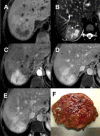Focal nodular hyperplasia with major sinusoidal dilatation: a misleading entity
- PMID: 22798311
- PMCID: PMC3029855
- DOI: 10.1136/bcr.09.2010.3311
Focal nodular hyperplasia with major sinusoidal dilatation: a misleading entity
Abstract
Focal nodular hyperplasia (FNH) is a benign liver lesion thought to be a non-specific response to locally increased blood flow. Although the diagnosis of FNH and hepatocellular adenoma (HCA) has made great progress over the last few years using modern imaging techniques, there are still in daily practice some difficulties concerning some atypical nodules. Here, the authors report the case of a 47-year-old woman with a single liver lesion thought to be, by imaging, an inflammatory HCA with major sinusoidal congestion. This nodule was revealed to be, at the microscopical level and after specific immunostaining and molecular analysis, an FNH with sinusoidal dilatation (so-called telangiectatic focal nodular hyperplasia).
Conflict of interest statement
Figures







References
-
- Wanless IR, Albrecht S, Bilbao J, et al. Multiple focal nodular hyperplasia of the liver associated with vascular malformations of various organs and neoplasia of the brain: a new syndrome. Mod Pathol 1989;2:456–62 - PubMed
-
- Nguyen BN, Fléjou JF, Terris B, et al. Focal nodular hyperplasia of the liver: a comprehensive pathologic study of 305 lesions and recognition of new histologic forms. Am J Surg Pathol 1999;23:1441–54 - PubMed
-
- Paradis V, Benzekri A, Dargère D, et al. Telangiectatic focal nodular hyperplasia: a variant of hepatocellular adenoma. Gastroenterology 2004;126:1323–9 - PubMed
-
- Bioulac-Sage P, Rebouissou S, Sa Cunha A, et al. Clinical, morphologic, and molecular features defining so-called telangiectatic focal nodular hyperplasias of the liver. Gastroenterology 2005;128:1211–18 - PubMed
-
- Bioulac-Sage P, Rebouissou S, Thomas C, et al. Hepatocellular adenoma subtype classification using molecular markers and immunohistochemistry. Hepatology 2007;46:740–8 - PubMed
Publication types
MeSH terms
LinkOut - more resources
Full Text Sources
